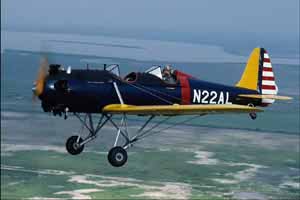Ryan PT-22 Recruit
U.S. Primary Trainer
 |
One of the Ghost Squadron's PT-22s. Image source: The Confederate Air Force Ghost Squadron CD-ROM produced by Corel. Photos by Bill Crump. |
The S-T and S-T-As featured open cockpits, a slim metal fuselage and an externally-braced wing, and were powered by a Menasco four-cylinder inline engine of from 95 to 125 hp. The fixed landing gear was of an unusual "knuckled" design, which on most of the civilian models was covered with a streamlined fairing. The design was popular, and in 1939 the Army Air Corps acquired one S-T-A for evaluation as a primary trainer, under the designation XPT-16. By the late 1930s, the USAAF realized the need for monoplane primary trainers to supplement its current fleet of biplane training aircraft, as the newer combat aircraft were all monoplanes. The XPT-16 was in fact the first monoplane primary trainer purchased by the Air Corps.
Fifteen YPT-16s were ordered in 1939 and another 30 in 1940, with the designation PT-20. Both were powered by the 125 hp Menasco engine, the PT-20 having wider cockpits and other changes to better suit military training needs. The Menasco engines did not provide as much power or reliability as the military desired, so some of the PT-20s were re-engined with five-cylinder Kinner R-440 radial engines, rated at 132 hp. The Kinner engine was also fitted to the 100 PT-21s ordered by the Air Corps in 1941 and the 100 similar NR-1 trainers for the U.S. Navy.
With the rapid expansion of U.S. air forces in 1941 came a similar increase in the need to train pilots and aircrews. In that year, Ryan received orders for the PT-22, officially named Recruit, which was powered by the larger Kinner R-540 engine of 160 hp. This was to be the major production model of the Recruit, with 1,023 built. On the PT-22, the landing gear fairings, also called "spats" were removed from the design, as they had made it difficult to inspect and repair the landing gear. Since a military primary trainer spent at least half of its time practicing landings and take offs with beginning pilots, care of the landing gear was more important that the slight gain in top speed that the spats provided.
Ryan also built versions of the S-T series for export to other countries including China and the Netherlands. Some of the Dutch STMs were fitted with floats and saw service against the Japanese in Java and the Dutch East Indies in 1942.
Specifications
| Pilot and Passenger/Instructor
One Kinner R-540-1 Engine Max. Speed 131 mph @ sea level Climb to 10,000 ft in 17 minutes |
Length 22' 5" Max. Weight 1,860 lbs Normal Fuel 24 gallons Normal Range 352 miles |